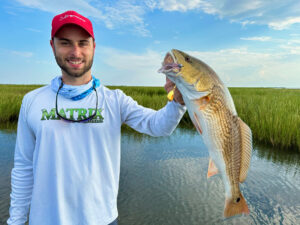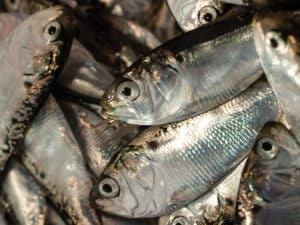STANDING ON THE FORWARD CASTING DECK, I heaved another big popper, full of determination, after several days fishing Oman — one of the globe’s giant trevally hot spots — without a monster GT.
Of course, chasing huge fish anywhere carries a crash-and-burn risk. That thought was in my mind when, halfway through my retrieve, I noticed a great commotion several hundred yards across the reef — a bust-up, as we call it out here.
I wasn’t initially sure what sort or sizes of predators were going off, but as our captain motored us closer, I could make out a pack attack of trophy GT, some well over 100 pounds.
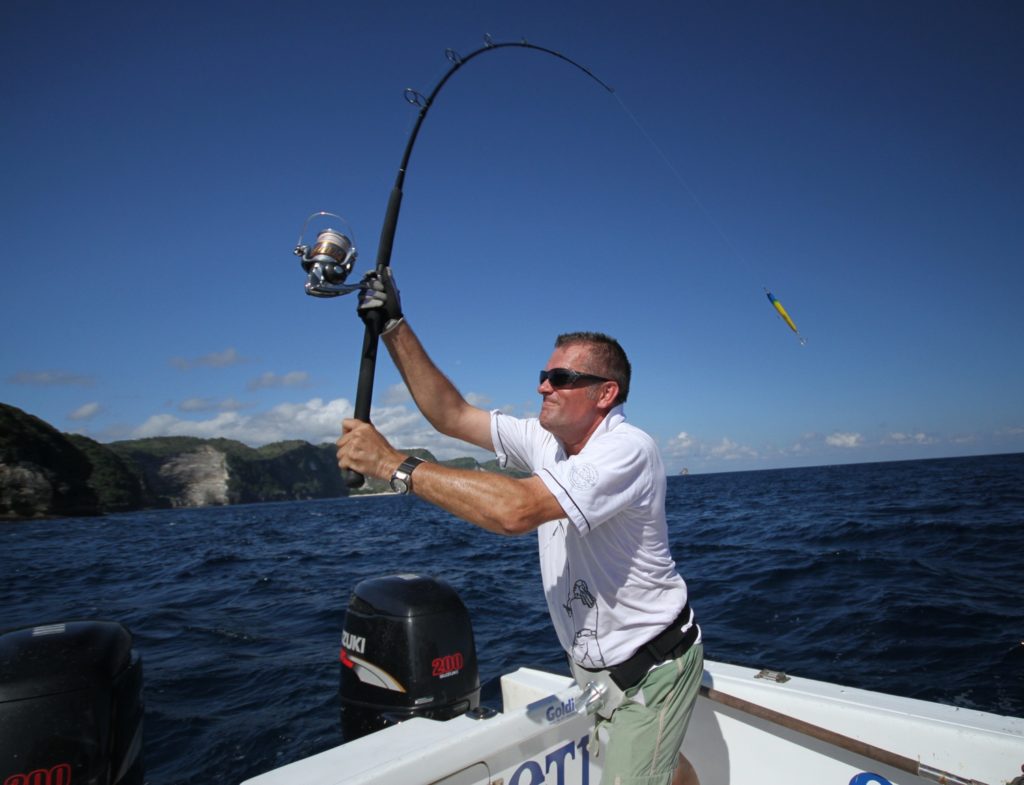
Before the boat had come to a stop, my buddy Stewart Newnham, from England, had fired into the melee. Almost the instant his popper touched down, it came under attack by monsters. Working with a 130-pound braid and heavy drag, Stu was under immediate attack and struggled to keep his balance as I fired a cast just left of the white water spraying from the frenzy.
On the first sweep, with line screaming out my guides, I struck back as hard as I could a half-dozen times to set the hooks. It may sound odd to worry about hook setting at such a moment, but plenty of times we’ve had GT drop off a lure after making a screaming first run.
Stu’s fish suddenly released itself by opening up a massive 7/0 treble hook. Meanwhile, I worked against 35 pounds of drag to keep from falling on my ass while not being pulled into the gunwale.
The fight was typical GT: brutal. Initially, during several grueling, unstoppable runs, all I could do was hang on, knowing my success would live or die according to the fish’s ability to find cover in a reef.
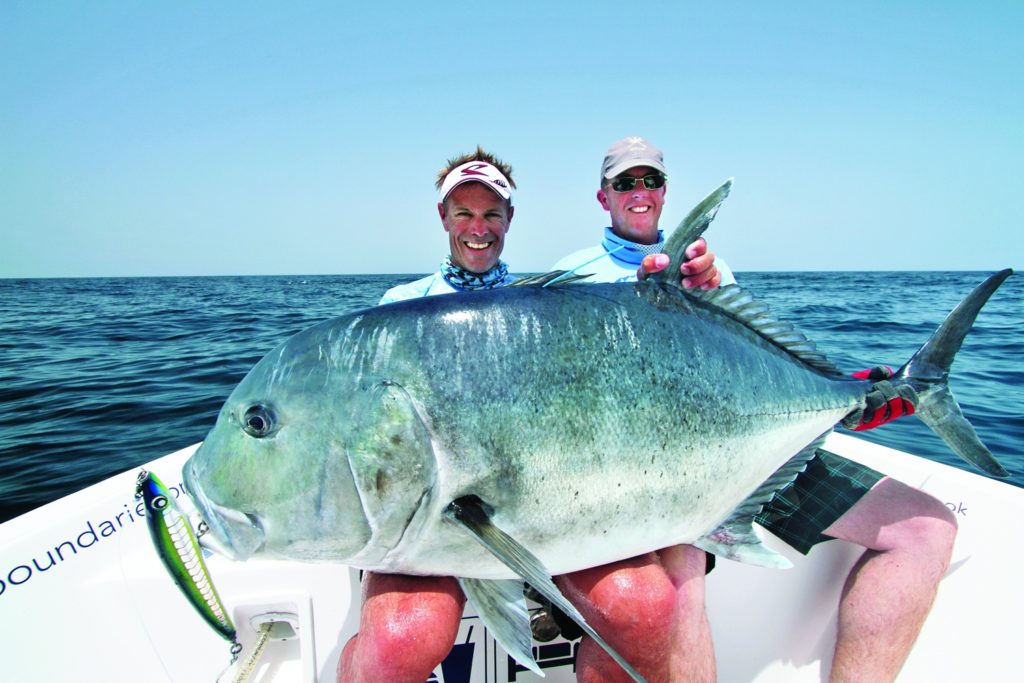
Once the hulking fish hadn’t been able to reef me, my goal became that of gaining line. Fish as massive and merciless as enormous GT have been known to leave anglers with damaged tendons or muscles or even a ruptured disk. Pull against a load with a reel set at 35 pounds of drag on an 8-foot rod for 10 or 20 minutes to get some idea.
After a prolonged battle like this, the joy of gaining the final feet of line can’t be adequately described.
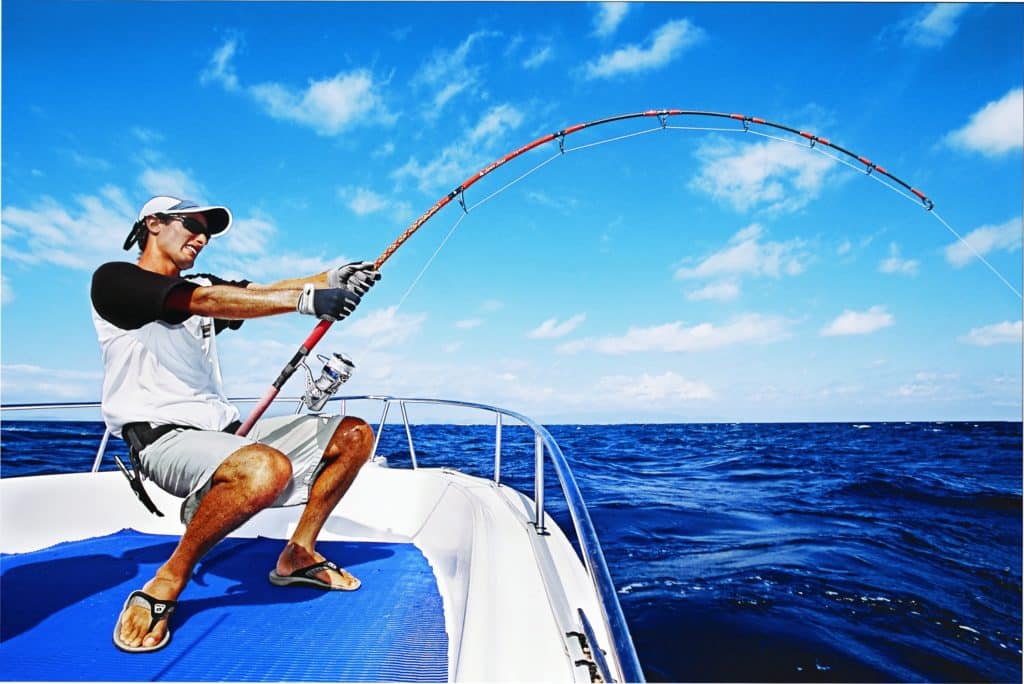
Globally, there’s a well-established movement of like-minded anglers intent in the pursuit of the biggest, baddest fish on the planet — GT and dogtooth and other tunas, among other game fish — whether by casting topwater lures or jigging.
Fishing is often considered a relaxing pursuit. People can achieve most aspects of our sport with moderate fitness. Casting big, heavy lures and working deep jigs, on the other hand, is at the far edge of the sport. Large, high-end spinning gear can be relatively heavy, and vigorously casting a 6- or 7-ounce plug up to 300 times in a day can sap even the fittest anglers of energy.
Long, fast-tapered rods are vital to distance casting but not terribly effective when fighting fish, acting as a large fulcrum against the angler. Against heavy drag settings, powerful fish tend to pull the rod down and away, offering the angler poor leverage. The result, in physical terms, can mean massive straining loads on spinal erectors (lower back), hamstrings (back of the upper legs), glutes (gluteus maximus, your butt), latissimus dorsi (the large, muscular “wings” on your upper back) and all the parts that hang on (hands, arms and shoulders).
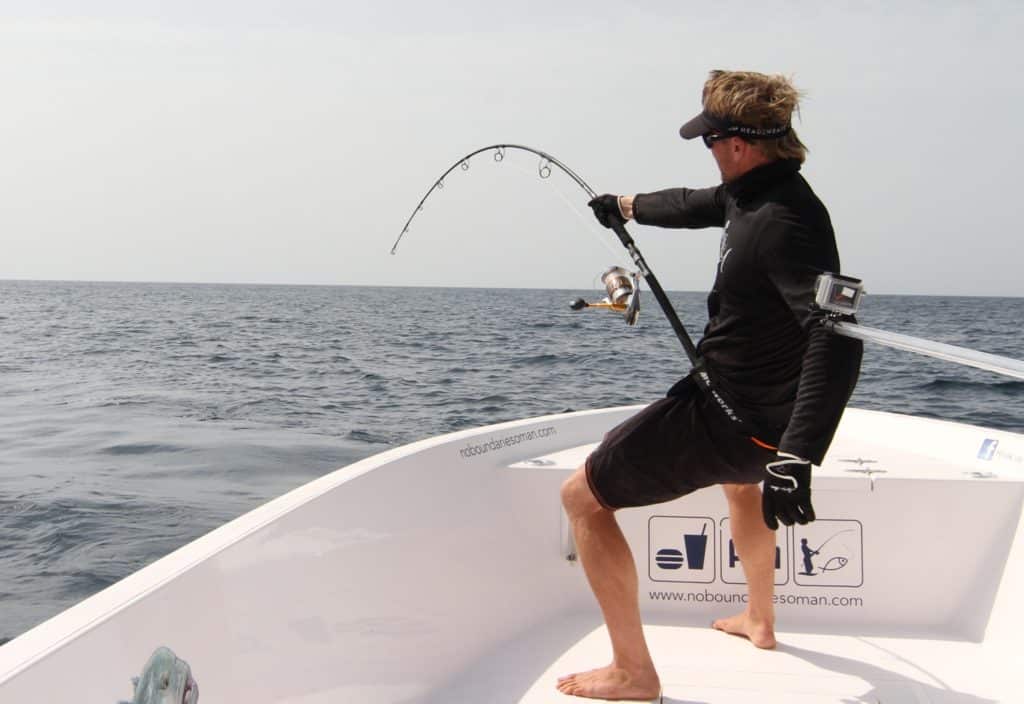
IF YOU’RE NOT IN GOOD SHAPE FOR SUCH FIGHTS, OR IF YOUR TECHNIQUE IS WRONG, YOU’RE LIKELY TO BE IN A WORLD OF HURT IN SHORT ORDER. AN ANGLER CAN BE PREPARED TO WIN BALLS-OUT BATTLES AGAINST BIG FISH, BUT THAT DOESN’T HAPPEN JUST FROM SITTING ON THE COUCH.
Physical preparation is the cornerstone required to execute good big-fish-fighting technique. A variety of factors influence how we prepare, including our age, size and shape, previous conditioning and injuries or illness. Typically, smaller anglers with less overall physical strength will focus on building that strength; larger and naturally strong anglers will likely need to concentrate more on cardio training.
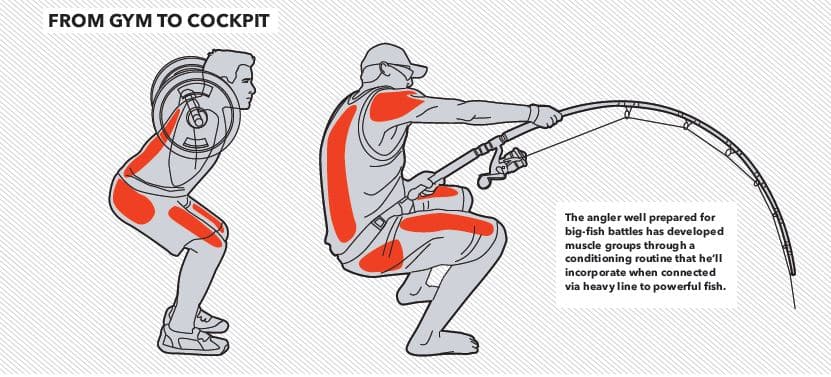
But both strength and cardiovascular conditioning are fundamental to us all. In terms of a philosophy, I subscribe to compound exercise, which recruits and engages multiple joints and muscle groups (like a squat where you move at the knee and the hip). Anyone familiar with CrossFit training (crossfit.com) will find those general principles effective for fish-fighting marathons as well.
On a personal level, my conditioning includes a variety of body-weight intensive exercises — those for which no equipment is needed, such as bodyweight walking lunges, pushups and chin-ups — as well as Olympic lifts in the weight room, and running and rowing machines for cardio blasts. My favorite exercises for staying in fish-fighting shape involve the use of an Olympic barbell and kettle bells — no need for a ton of fancy gear.
What follows is a brief list of what I do to stay in shape. I typically perform this routine at least twice a week.
Front squats, kettlebell swings (kettlebell sumo high pull), deadlifts and lunges
Eliminate any temptation to do useless isolation exercises like leg extensions; they’re pointless for what we are trying to achieve. That’s because isolation exercises tend to increase muscle size (think bodybuilding) in a certain area but do little to increase the strength or functional ability of the muscle to generate power in movements that do not mimic the isolation. I try to train these large muscles so they become strong enough to protect my back.
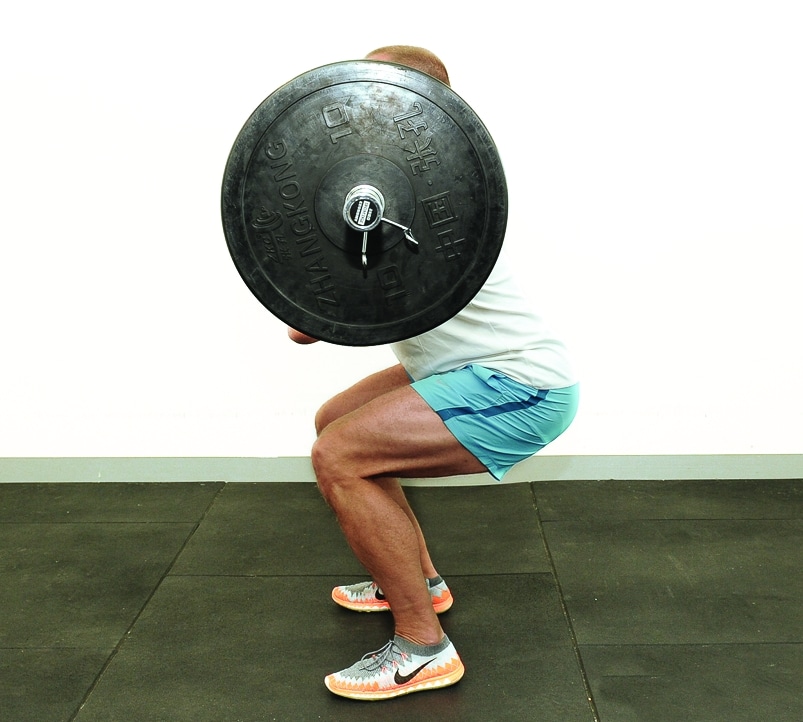
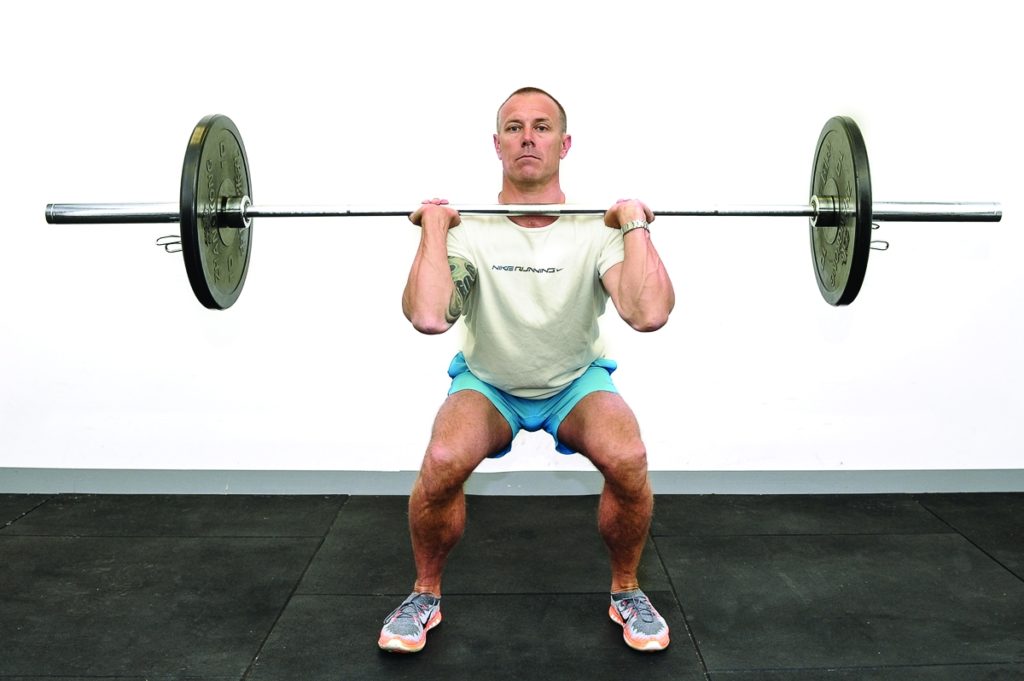
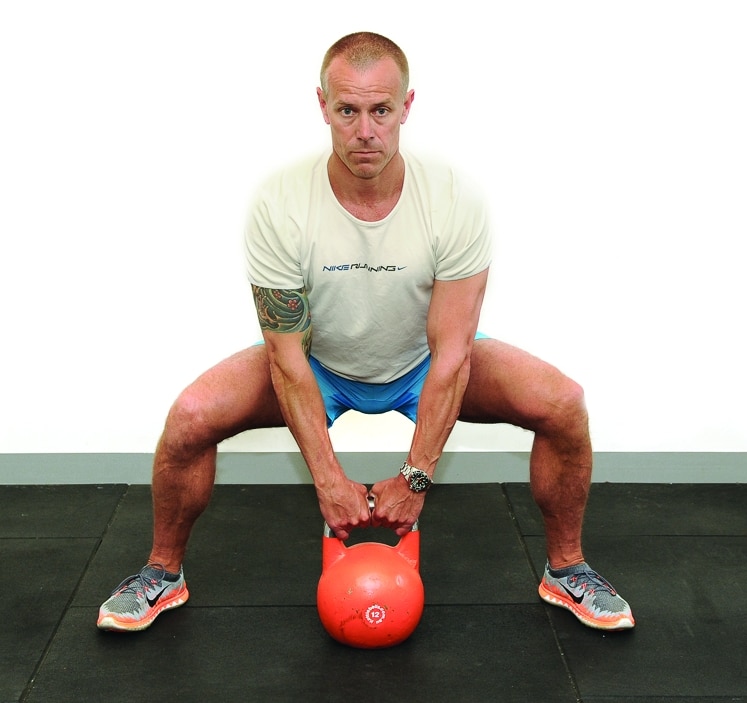
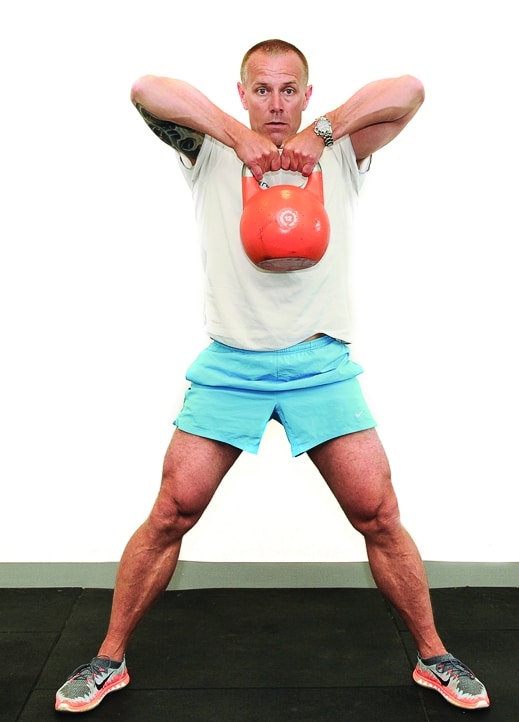
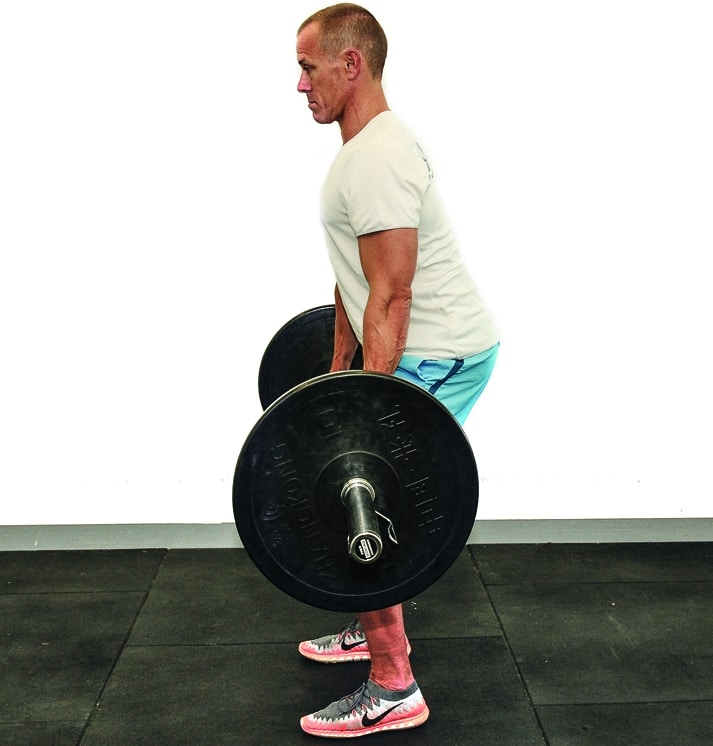
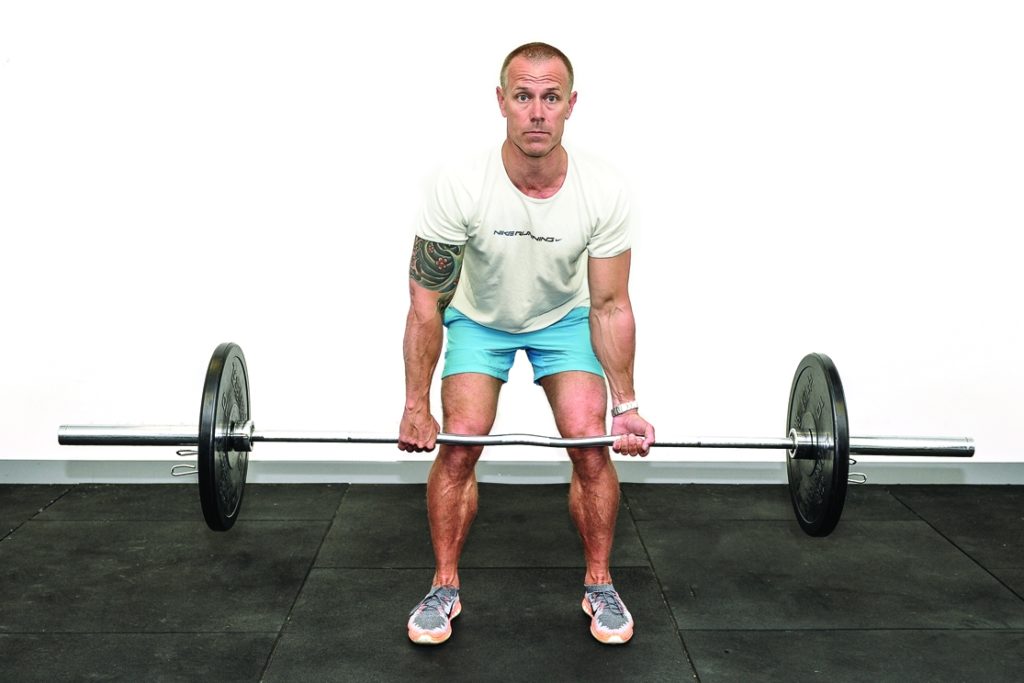
Back
Your back is the most vulnerable part of your body when engaged in tough battles with fish below the boat — that is, where the line is more or less vertical.
Good mornings, hyperextensions, Pull-ups and bent-over rows are worthwhile, as is the king of exercises, the barbell dead lift. I want a strong back so it’s capable of pulling powerfully and is less vulnerable to injury .
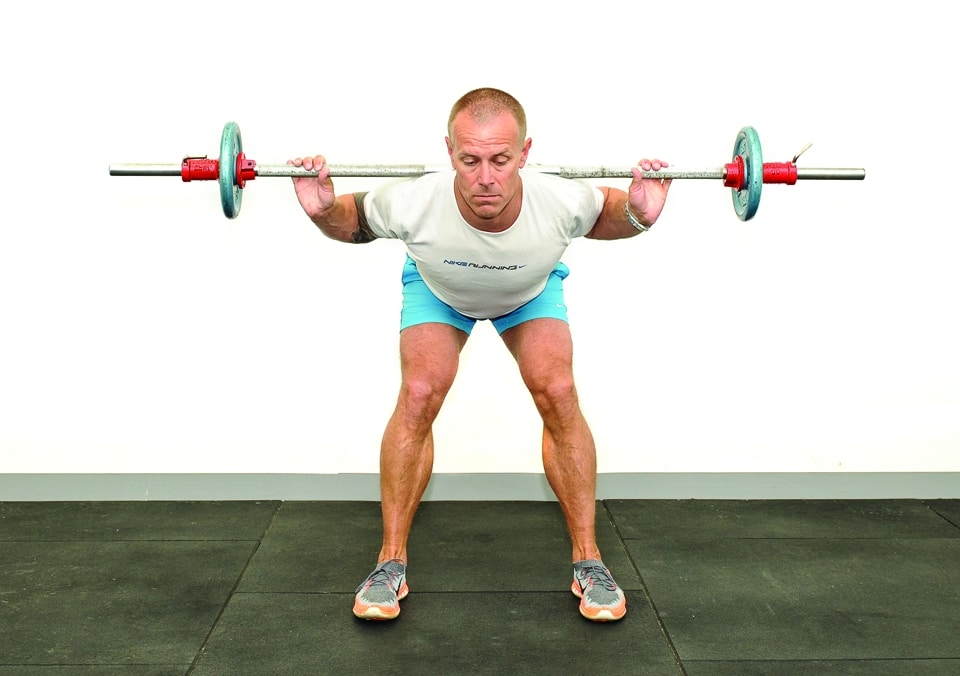
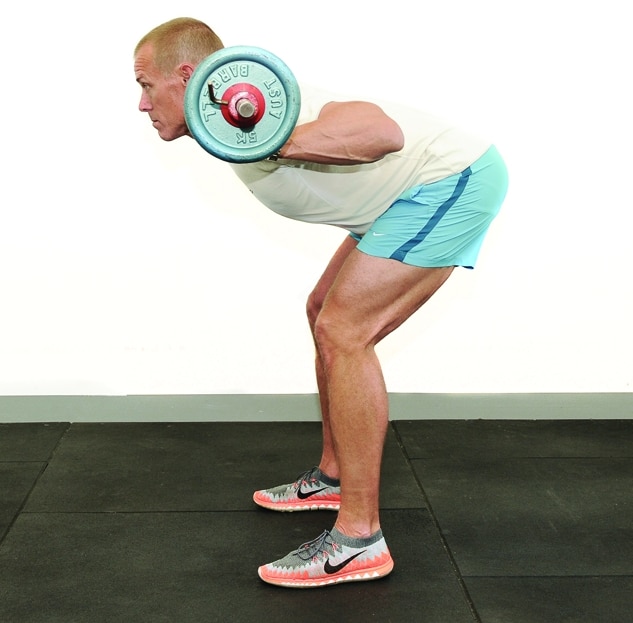
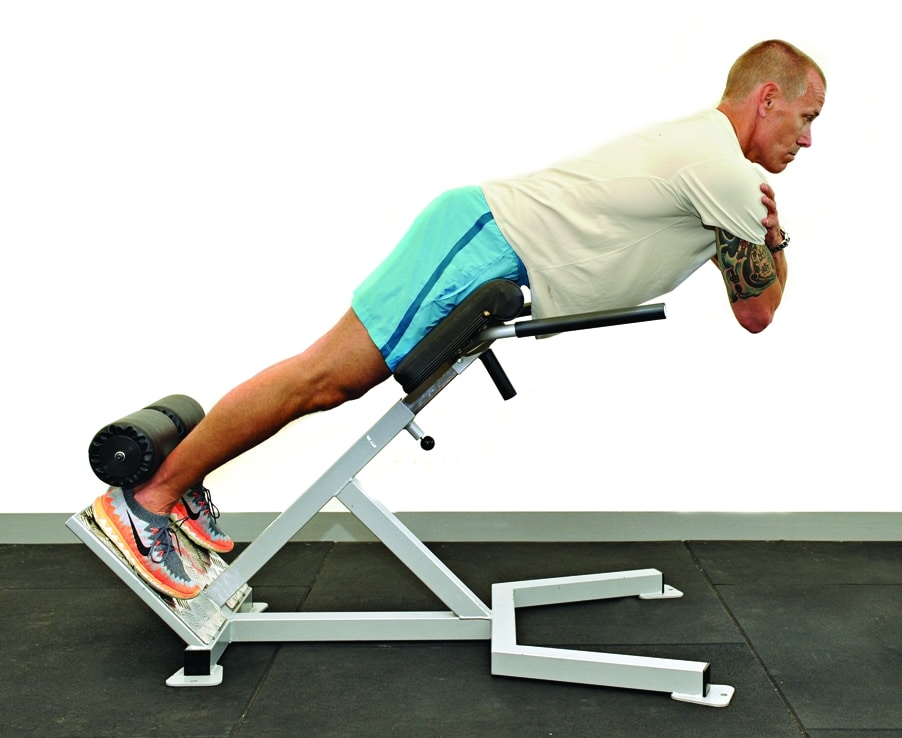
Stomach
Cross-body crunches, planks, traditional situps and medicine-ball twists. Deep abdominal exercises are critical for protecting the spine and preparing for the rotational forces in casting and working large lures for sustained periods. A strong core is the best insurance you can have for protecting the spine, apart from good technique. The core is a complex series of muscles centered on the torso, extending far beyond the abdominals (think six-pack), including everything besides your arms and legs. The core is incorporated in almost every movement of the human body and can be a static or dynamic stabilizer for movement, as well as transferring force from one extremity to another or to initiate movement.
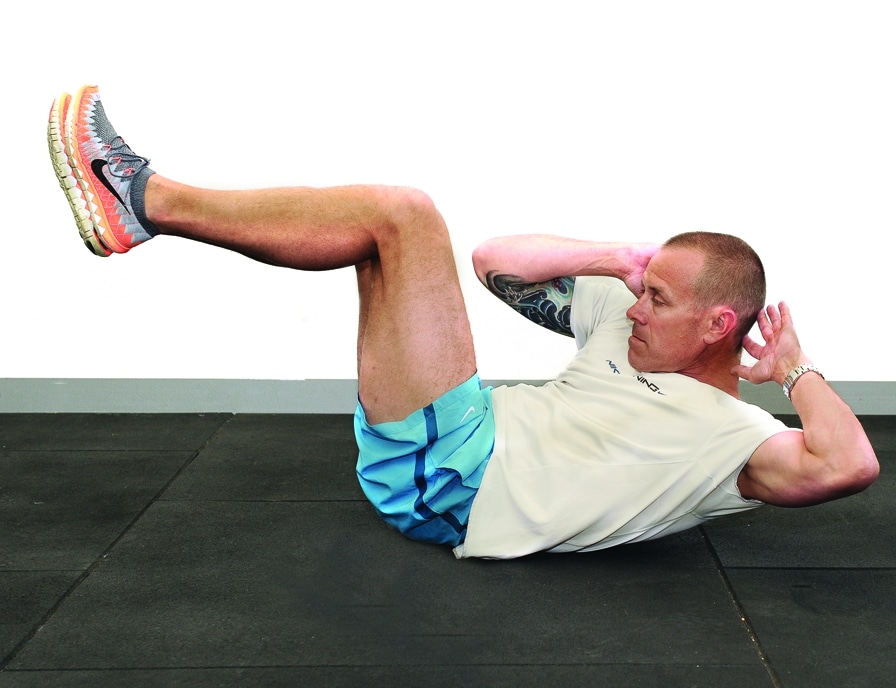
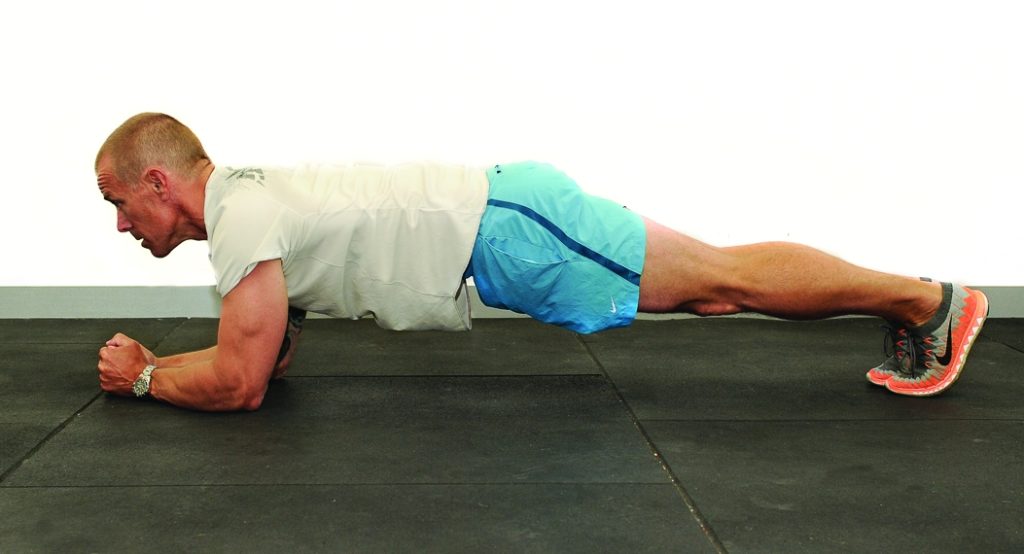
Frontal Upper Body
The snatch, barbell shoulder presses (aka military presses), push-ups, bench presses and upright rows. Also, the clean-and-press recruits almost every muscle in the body and bears strong resemblance to the activity of casting and fighting fish. I’m happy to train the front (pecs) weekly. Because fish fighting is largely a pulling movement and the pectorals are pushing muscles, they have a lesser role in fish fighting but plenty of involvement in casting.
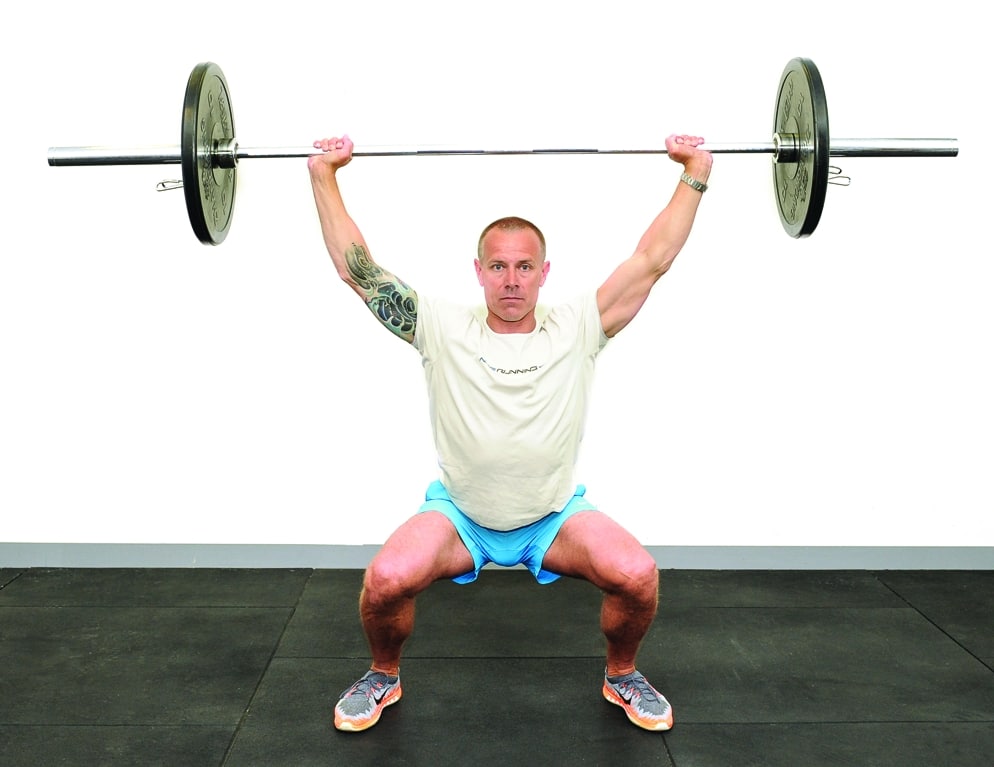
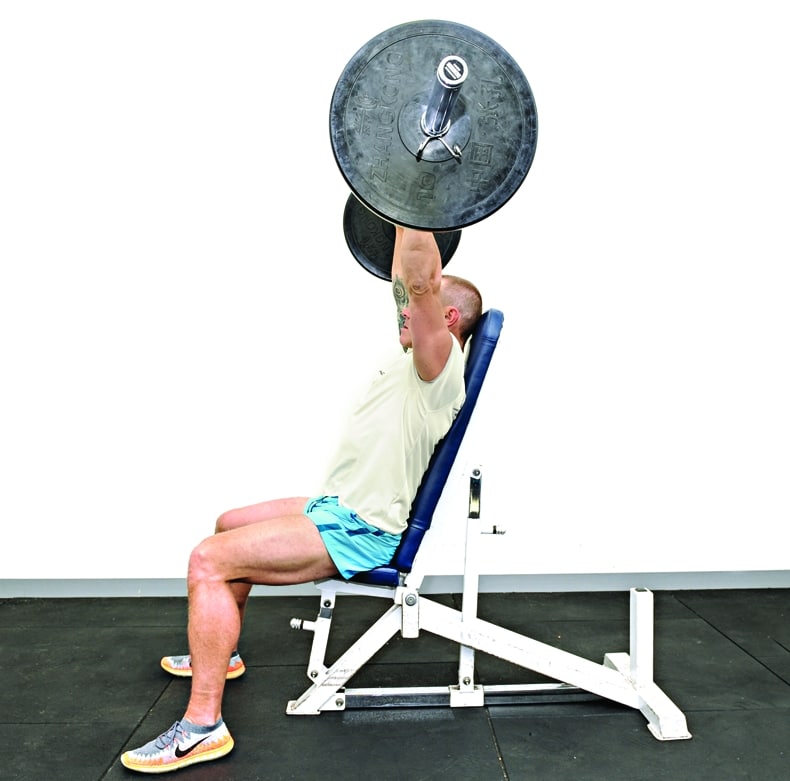
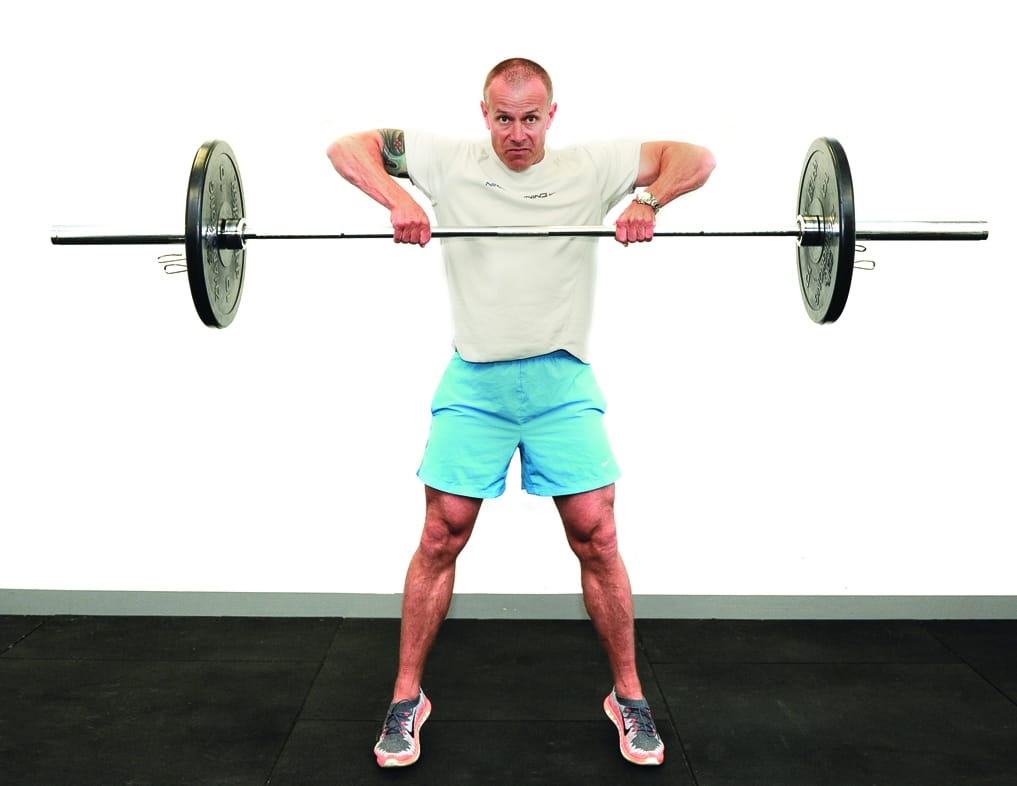
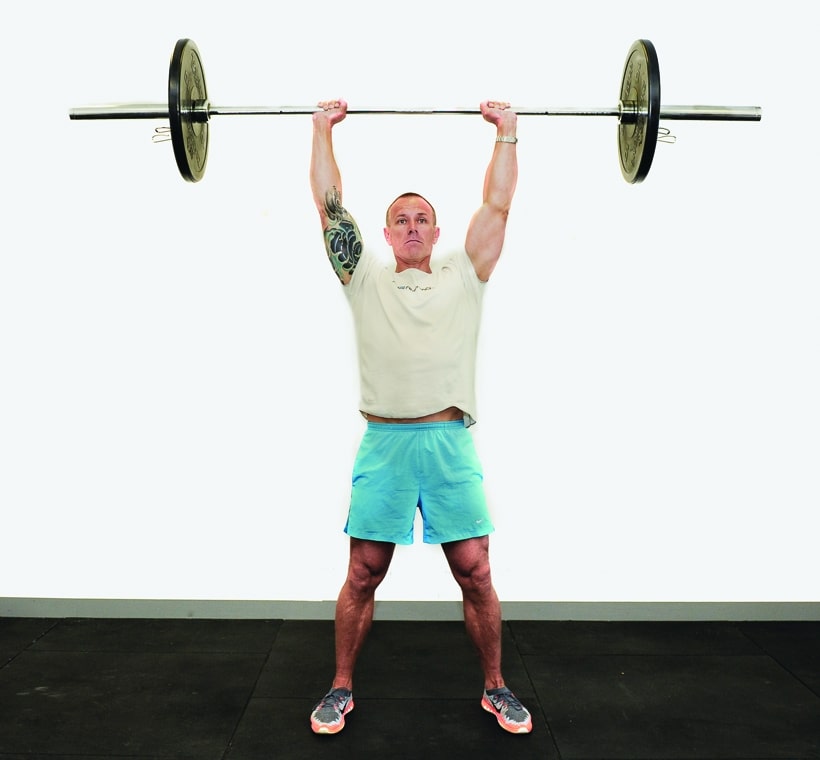
ONCE YOU’RE PHYSICALLY PREPARED, THE KEYS TO SUCCESSFULLY FIGHTING FISH SUCH AS BIG GT ON HEAVY STAND-UP TACKLE ARE CORRECT POSTURE AND TECHNIQUE. A PRIMARY GOAL IS TO GET THE LEGS TAKING AS MUCH OF THE LOAD AS POSSIBLE, REDUCING THE STRAIN ON THE LOWER BACK THROUGH ALL THE STAGES OF THE FIGHT.
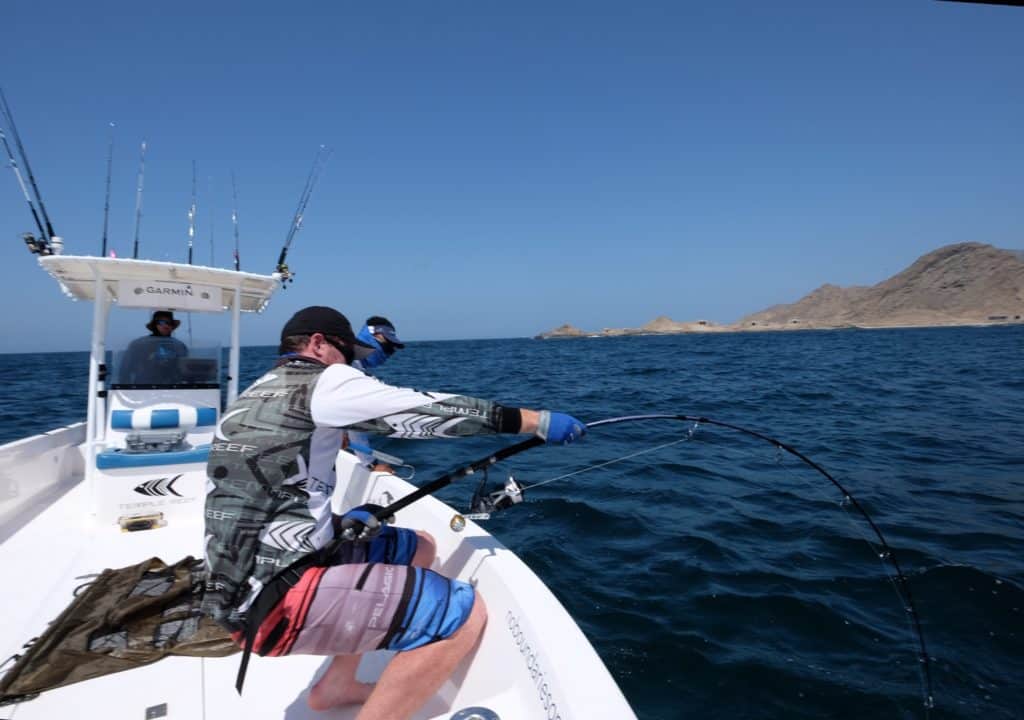
Technique is Vital
Always aim to keep your arms relatively straight for much of the fight to reduce fatigue on small-muscle groups. It’s a great strategy, and you’ll be thankful for doing so in the latter stages of the fight.
Inevitably, a fight will get really tough when a fish runs vertically under the boat or is circling deep below, not quite taking drag but seemingly unmovable. This is probably the toughest stage of a monster battle and the point where your conditioning will be needed most.
An upright fighting posture is not viable in this situation; the forces working against you are likely to have you kissing the deck. The strategy for vertical — when fish dive under the boat — battles calls for getting low by bending the legs and almost sitting down into a squat with close to a 90-degree bend in the legs. With adequate conditioning, you can lean back from the hips and use your legs. Keep your back strong (upright) and don’t round it. In this position you’re putting yourself in the best position to combat the length of the rod and the bad line angle.
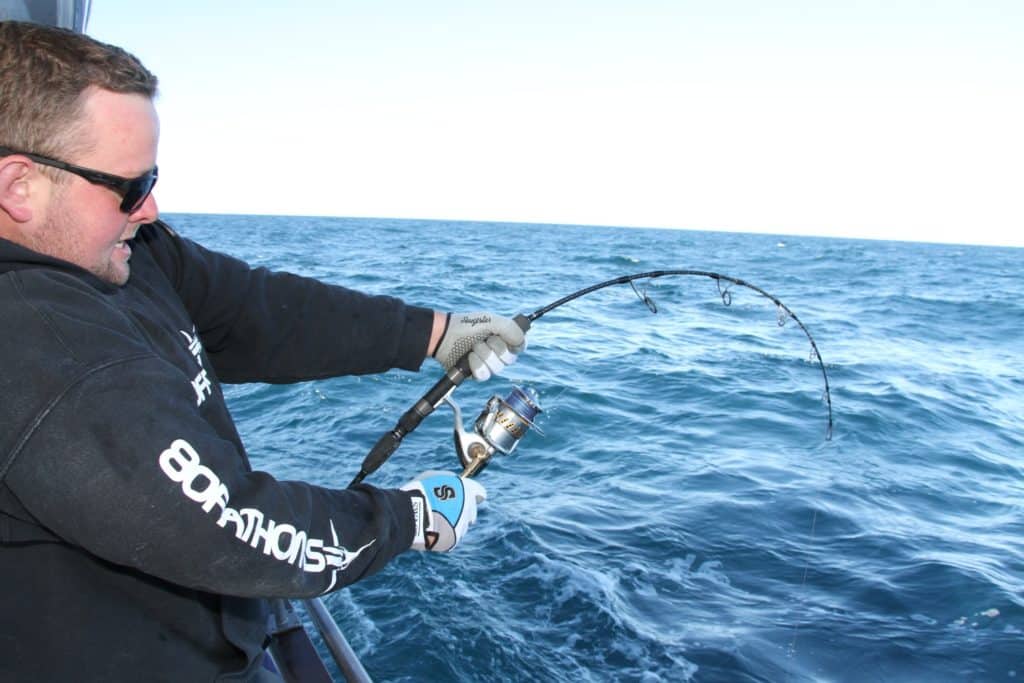
Once you think you’re in a position to gain some line back, ready yourself to push up to a standing position. Keep a straight back, and using straight arms to hold the rod in a semifixed position, pull the fish up through the water column as you return to a standing position. The return to the squat position is the opportunity to gain line as you crank down on the reel in a modified pump-and-wind.
Anything the skipper can do to drive away from the fish, keeping an angle between you (the angler) and the fish, is a bonus. A fish circling deep just under the boat is trouble, and can be a fast path to pain and potential failure.
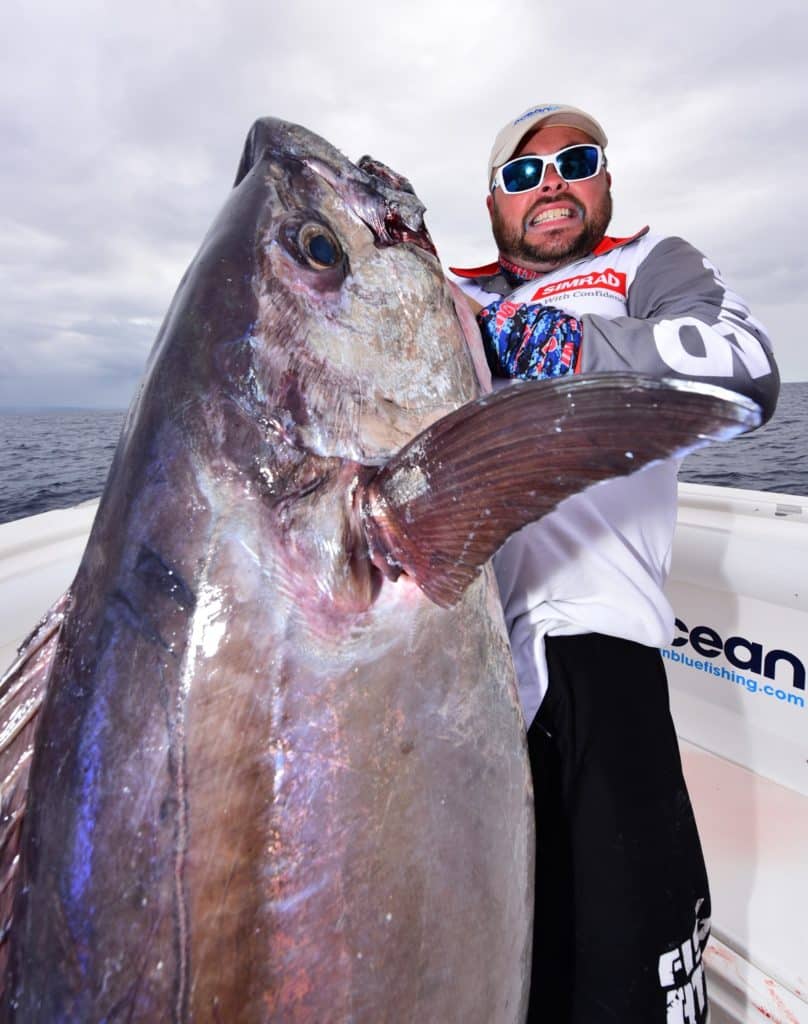
I’m as guilty as the next guy in letting good technique go out the window as the fight nears an end and I get fatigued. The best advice I can offer is to resist the urge to try to gain several turns of the handle as you pump and wind. Invariably, this action leads to high-sticking the rod and gives the fish a chance to turn its head and dive, prolonging the fight. Short stroking is the best bet; settle for small gains with each stroke. Don’t be greedy with how much line you’re getting back.
With game fish like GT, battles are won or lost fairly quickly — it’s really a sprint of sorts, so keep the fish’s nose facing you as best you can. The best big-fish fighters I’ve seen get back the line a half-turn at a time and always keep the rod in the ideal fighting position, with the load on the fish, not themselves.
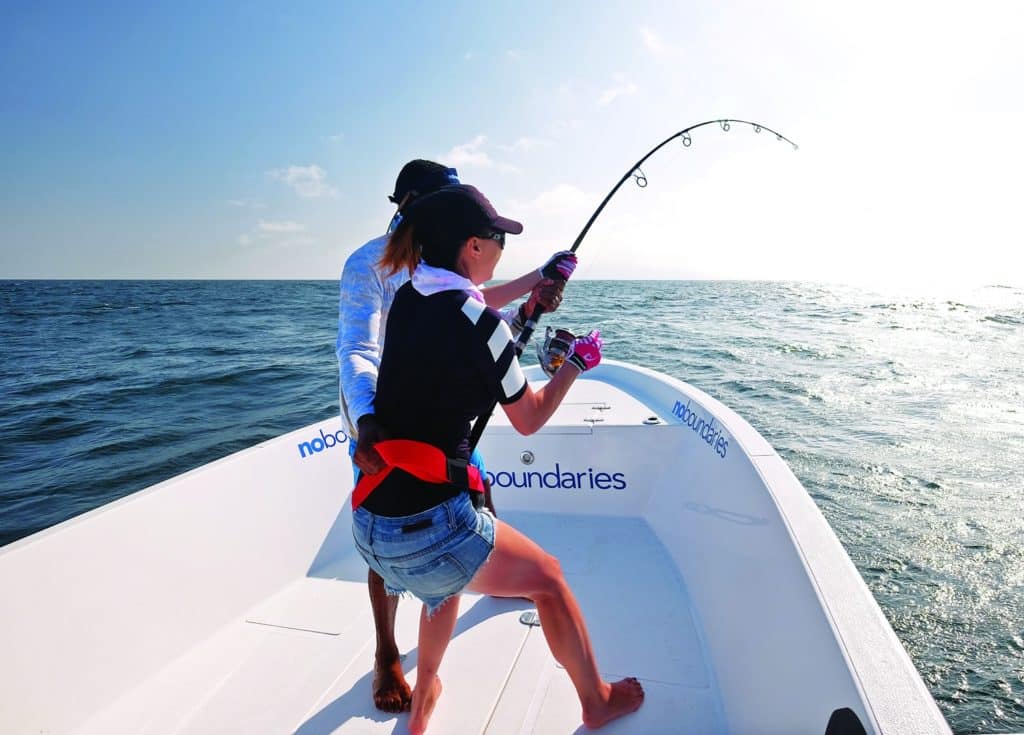
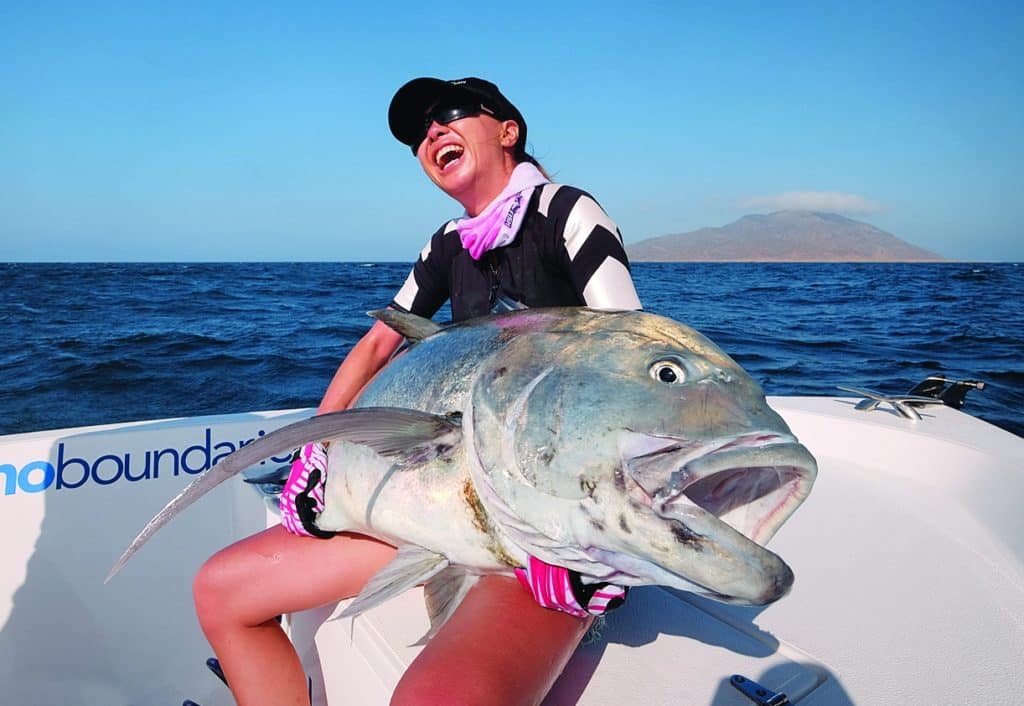
Gear and Accessory Considerations
Casting heavy poppers means heavy braided line, fished on as tight a drag as you can handle and, of course, with the heaviest rods in the reel’s class that you’re capable of fishing. While the pursuit of monsters calls for the toughest gear, there’s no point fishing tackle beyond your capabilities. Rods that don’t bend for you and drag so tight it leaves you incapable of remaining standing are not the answer.
A fighting belt is essential. You don’t want 30-plus pounds of drag pressure pushing against your groin, so you need to be wearing a belt all day while waiting for the strike — because once that happens, you’re likely to need it fast.
Harnesses are seldom recommended in this style of fishing; they often get in the way when fish change direction and the angler needs to drop the rod tip into the water to clear hulls and propellers. Condition yourself, understand your capabilities and fish hard to that limit in a way that will make sense and be an effective approach to an extreme sport. Are you up for the rigors of battling monsters?
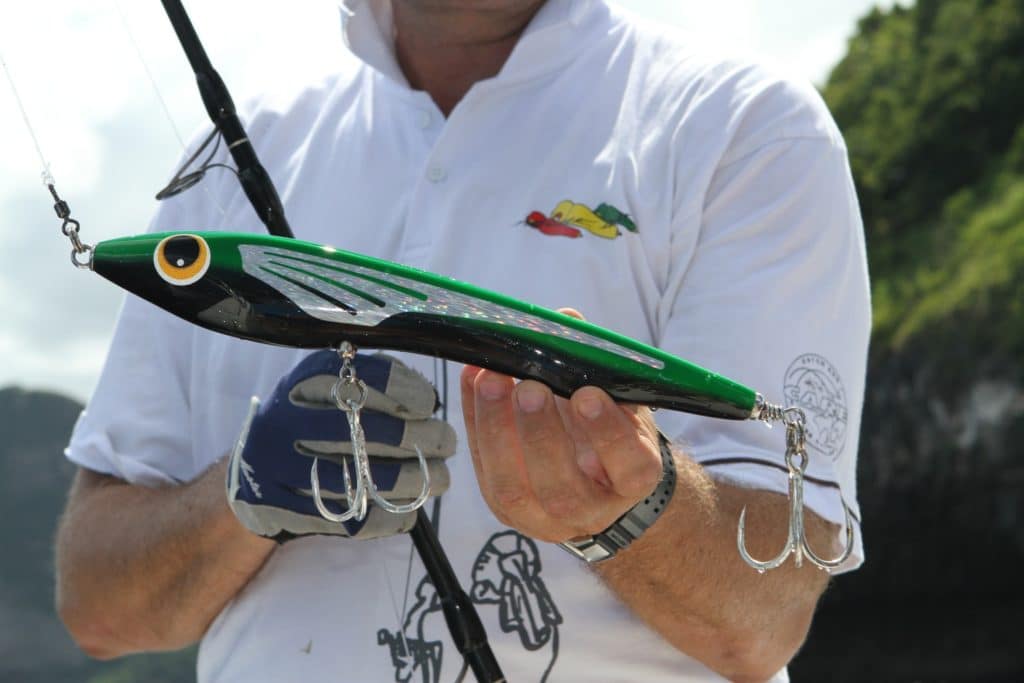
Terminal Tackle Tips
When you’re dealing with truly massive fish, it’s a hardcore fight, requiring brutal tactics with a very heavy drag to convert a monster on the line into a monster at the boat. That is often not achieved, and frequently, the final analysis comes down to tackle choices. Hooks are the most likely thing to let you down, by straightening out and sometimes simply breaking in the jaws of huge GT. The immense jaw power of the fish combined with super-tight drags, and the need to sometimes tow fish away from the reef with the boat, make any head-shake a chance for a hook to fail.
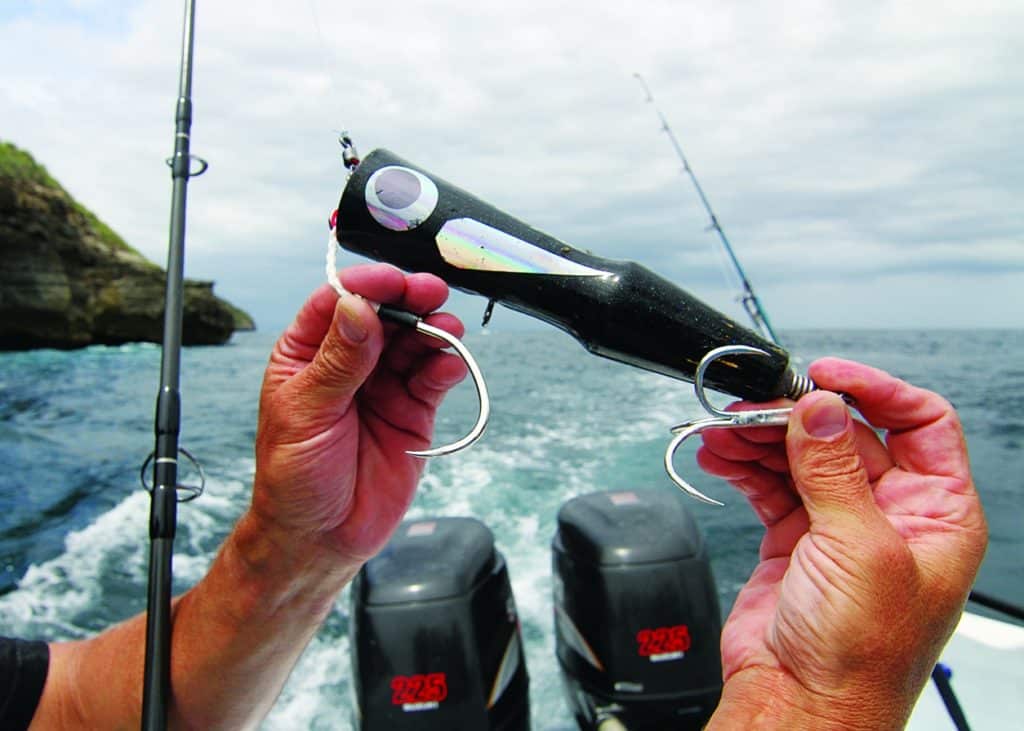
In this extreme fishing, you need the biggest trebles and singles that you can fit on any given lure, and split rings and swivels to match. Often, serious topwater lures are fitted with assist singles only, and in fact, singles are preferred, except on those lures that just won’t swim right with them. The weight of these large hooks dictates to an extent which lures you are going to need. Not every popper and stickbait can handle such large and heavy hardware. Swimming action and buoyancy can be severely affected, so the list of lures capable of performing is smaller than you might first imagine.
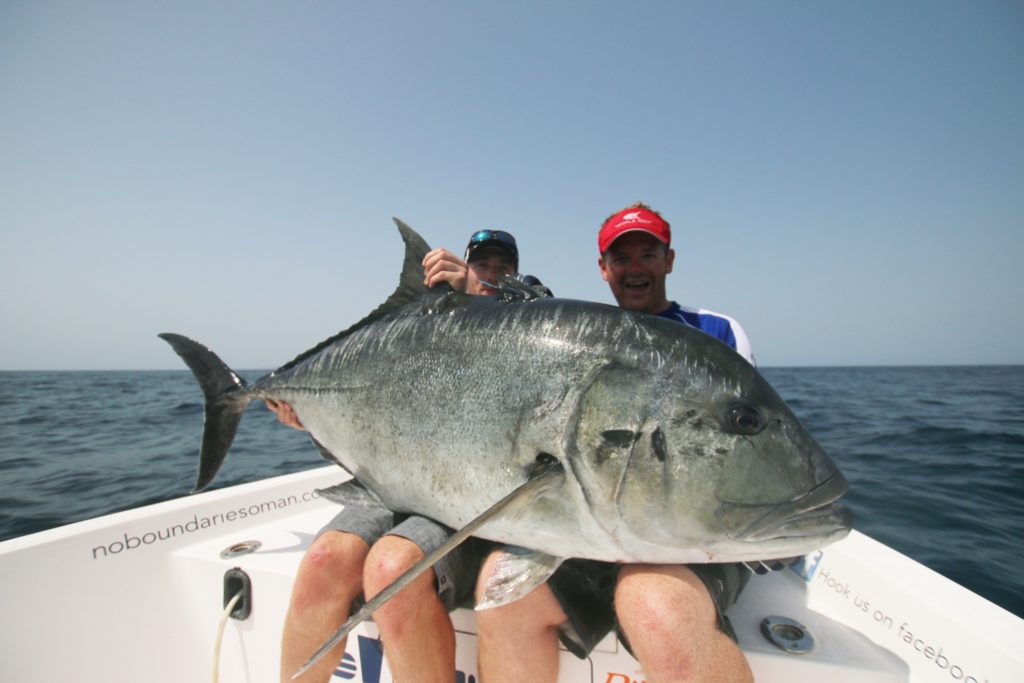
Southern Oman has a reputation as the global spot to take on oversize giant trevally. The exact reason why it’s so good lacks scientific explanation, but the number of jumbos — truly world-class trophies — is out of the typical proportion when compared to the actual numbers of GT. Oman has a prevalence of big, fat bait. Rafts of fusiliers, mullet and sardines by the ton and smaller pelagics abound, keeping the GT well fed. One of the explanations for plentiful bait and trevally might lie with the area’s unique geography. Around the Hallaniyat Islands, annual monsoons turn the hot, dry desert into a wet, cold misery. Coral reefs and cold-water kelp beds exist in this single location. Resident humpback whales stick around these waters rich with plankton. For more information on fishing these waters, contact No Boundaries Oman.



